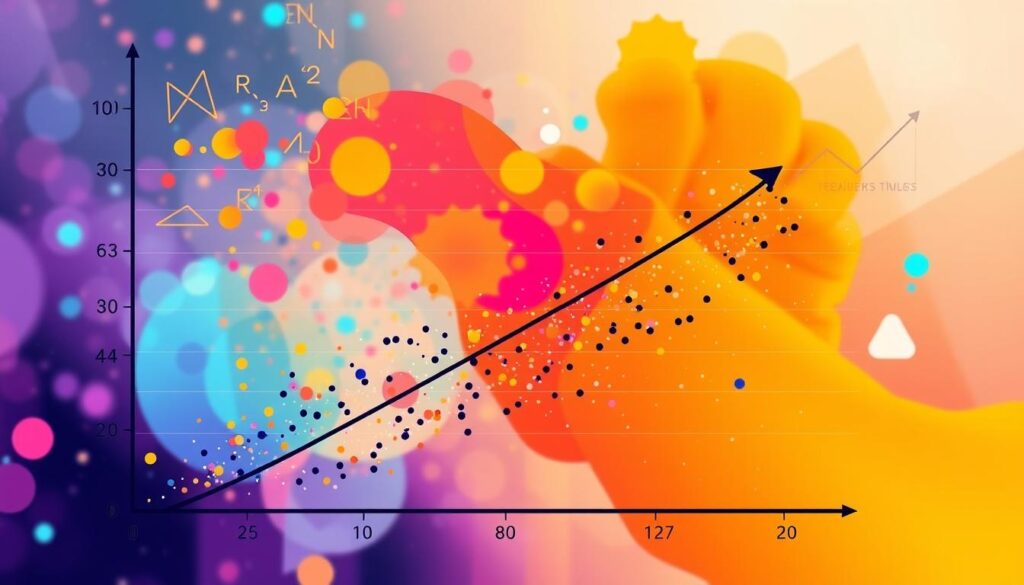“As an Amazon Associate I earn from qualifying purchases.” .
Ever wished you could see your business’s future? I felt like I had a superpower when I first learned about predictive analytics. It cleared the fog, showing a clear path ahead.
Imagine making decisions like a chess grandmaster, always ahead. Predictive analytics offers this promise. It’s not about magic; it’s using data to forecast trends and gain an edge.
Companies using this tech see profits jump by 15-20%. It’s like having a secret weapon. They’re not just surviving; they’re thriving by anticipating outcomes and reducing risks.
Predictive analytics isn’t just for one industry. It’s changing how we tackle challenges and grab opportunities in healthcare, finance, retail, and manufacturing. It’s our compass in the stormy seas of market changes and consumer tastes.
But it’s more than just numbers. It’s about telling stories with data, finding hidden patterns, and making stats easy for everyone to understand. It turns raw data into insights that lead to real results.
Key Takeaways
- Predictive analytics boosts profitability by 15-20%
- It enables data-driven decisions across industries
- Forecasting trends becomes more accurate
- Competitive advantages are gained through insights
- Risk reduction and operational optimization are key benefits
- It transforms raw data into actionable business strategies
Understanding Predictive Analytics
Predictive analytics is a big deal in today’s business world. It uses data mining, machine learning, and statistical techniques to guess what will happen next. This tool helps companies make smart choices based on data.
Definition and Key Concepts
Predictive analytics looks at past and current data to guess future events. It uses methods like:
- Linear regression
- Logistic regression
- Decision trees
- Neural networks
These methods help find patterns in data. This makes predictions more accurate.
Importance in Business
Predictive analytics has many benefits for businesses:
- Improved customer targeting
- Increased customer retention
- Fraud prevention
- Optimized operations
- Enhanced decision-making
Amazon uses it for product suggestions. Capital One uses it for credit risk checks. These examples show how valuable predictive analytics is for business success.
How It Differs from Traditional Analytics
Predictive analytics looks to the future, not just the past. It gives insights that help shape business strategies. This forward-thinking approach helps companies stay ahead and make smart decisions.
“Predictive analytics is not just about understanding what happened, but anticipating what will happen next.”
By using machine learning and advanced stats, predictive analytics turns data into a business advantage. It drives growth and innovation in today’s data-rich world.
The Evolution of Predictive Analytics
Predictive analytics has grown a lot over the years. It has changed from simple models to complex systems. This change has greatly influenced how businesses make decisions. Let’s look at how it has evolved and what the future holds.
Historical Context
In 1958, Dr. Eugene J. Kelley started using consumer data for store locations. This was the start of using data to make decisions. Over time, Business Intelligence (BI) moved from just reporting to more detailed analysis.
OLAP technology made analyzing big data faster and more detailed. This led to the ability to analyze data in real-time.
Technological Advancements
The rise of big data and cloud computing has changed predictive analytics. Tools like Tableau and Power BI let non-tech people analyze data. The addition of artificial intelligence and machine learning has made predictions even better.
Future Trends
The future of predictive analytics is exciting. AI-powered BI and augmented analytics will make data analysis easier. Real-time analytics will help businesses make quick decisions.
By 2024, 89% of companies plan to use advanced analytics. This shows how important predictive analytics is becoming.
| Company | Predictive Analytics Impact |
|---|---|
| Souq.com (Amazon.ae) | Increased conversion rates, reduced ad spend |
| Emirates Airlines | Higher booking rates, improved customer loyalty |
| Majid Al Futtaim | Enhanced customer experiences, reduced over-stocking |
| Netflix | Increased viewing time, higher user engagement |
| P&G | Optimized ad spend, improved ROI & ROAS |
As predictive analytics keeps evolving, businesses are seeing big benefits. From retail to airlines, companies are using these tools. They are improving customer experiences, making operations better, and growing in a data-driven world.
The Role of Data in Predictive Analytics
Data is key to predictive analytics. It powers the models that guide business decisions. The quality and type of data greatly affect prediction accuracy.
Types of Data Used
Predictive analytics uses both structured and unstructured data. Structured data has numbers and categories. Unstructured data includes text and images. A McKinsey study shows real-time data analytics can increase efficiency by 25%.
Data Collection Techniques
Companies collect data from many sources. These include customer interactions, social media, and internal systems. Nielsen notes that 63% of consumers find new products on social media, showing social data’s importance.
Data Quality and Governance
Good data quality is essential for accurate predictions. This means cleaning and preparing data. Data governance ensures it meets regulations and ethical standards. Epsilon found 80% of consumers like personalized experiences, highlighting the need for quality, governed data.
| Data Type | Example | Importance |
|---|---|---|
| Structured | Sales figures | Easy to analyze |
| Unstructured | Customer reviews | Rich in insights |
| Real-time | Social media posts | Timely decision-making |
Methods and Algorithms in Predictive Analytics
Predictive analytics uses many techniques to guess future trends and results. These methods help businesses make smart choices and stay ahead.
Regression Analysis
Linear regression and logistic regression are key tools in predictive analytics. Linear regression predicts continuous outcomes, while logistic regression handles binary results. These methods analyze relationships between variables to make predictions.

Machine Learning Techniques
Decision trees and neural networks are powerful machine learning algorithms. Decision trees create rule-based models for classification and prediction. Neural networks mimic brain function to recognize complex patterns in data.
Time Series Analysis
Time series analysis is key for sequential data. It helps forecast future values based on past observations. This technique is valuable for predicting sales, stock prices, and other time-dependent variables.
| Method | Use Case | Benefit |
|---|---|---|
| Linear Regression | Sales Forecasting | Predicts Continuous Outcomes |
| Logistic Regression | Customer Churn | Handles Binary Outcomes |
| Decision Trees | Risk Assessment | Easy to Interpret |
| Neural Networks | Image Recognition | Handles Complex Patterns |
| Time Series Analysis | Stock Price Prediction | Forecasts Sequential Data |
By 2025, global data is expected to reach 180 zettabytes. This surge in data highlights the growing importance of predictive analytics across industries.
Applications of Predictive Analytics in Business
Predictive analytics changes how companies work. It uses data and algorithms to guess what will happen next. This tool helps businesses make better choices in many areas.
Customer Behavior Prediction
Knowing what customers want is key to success. Predictive analytics helps sort customers into groups. This way, businesses can offer what they really want.
By looking at past buys and online actions, companies can guess what customers will buy next. This leads to better marketing and happier customers.
Risk Management
Fraud detection is a big deal for predictive analytics. Banks use it to catch odd transactions and stop fraud. Insurance companies use it to figure out who’s at risk.
This approach saves a lot of money that could be lost to fraud.
Inventory Optimization
Knowing what to stock is key for inventory management. Predictive models look at sales, trends, and more. This helps businesses have the right products at the right time.
This reduces waste and helps with cash flow.
Marketing Campaign Effectiveness
Targeted marketing gets a big boost from predictive analytics. It helps guess how customers will react to ads. This makes campaigns more effective.
It leads to more sales and better use of money. Email, social media, and personalized content all get better with these insights.
| Application | Benefit | Example |
|---|---|---|
| Customer Segmentation | Personalized Marketing | Netflix movie recommendations |
| Fraud Detection | Reduced Financial Losses | Credit card transaction monitoring |
| Demand Forecasting | Optimized Inventory | Amazon’s anticipatory shipping |
| Targeted Marketing | Improved ROI | Facebook’s ad targeting system |
The predictive analytics market is growing fast. It was worth $14.9 billion in 2023 and is expected to hit $41.44 billion by 2028. This shows how important it is for making business decisions.
Industries Benefiting from Predictive Analytics
Predictive analytics is changing many sectors, making things better and more efficient. Let’s see how different industries use this tool to improve their work and results.
Healthcare
In healthcare, predictive analytics is key to better patient care. It helps doctors predict health risks and create custom treatment plans. This way, they can act early and give care that fits each patient’s needs.
Finance
Financial groups rely on predictive analytics for smart money planning. Banks and investment firms study market trends and customer habits. They use this info to spot risks, catch fraud, and make smart investment choices. This makes their finances stronger and builds trust with customers.
Retail
Retailers use predictive analytics to make shopping better for customers. For example, Nike uses it to guess how many products to make and where to sell them. Zara uses it to manage its stock, adjusting amounts based on what’s selling fast.
Manufacturing
In manufacturing, predictive analytics helps make supply chains better. Companies like Pfizer use software to boost how well they work. Rockwool uses it to control complex production, like environmental systems. This reduces mistakes and makes products better and faster.
| Industry | Application | Benefit |
|---|---|---|
| Healthcare | Patient Risk Assessment | Improved Patient Outcomes |
| Finance | Market Analysis | Accurate Financial Forecasting |
| Retail | Demand Prediction | Enhanced Customer Experience |
| Manufacturing | Process Automation | Supply Chain Optimization |
By using predictive analytics, these industries are setting new standards. They’re getting better at being efficient, making customers happy, and innovating. Seeing trends and challenges ahead is helping them stay ahead and keep improving.
Building a Predictive Analytics Strategy
Creating a solid predictive analytics strategy is key to unlocking powerful data insights. This process involves setting clear business goals, identifying key performance indicators, and choosing the right analytics platforms.
Defining Objectives
Start by pinpointing your organization’s specific needs. Are you aiming to boost sales, improve customer retention, or streamline operations? For example, a fashion retailer used predictive analytics to increase repeat purchases by 20% within six months.
Identifying Key Metrics
Once objectives are set, determine the metrics that best measure success. These performance indicators should align with your business goals and provide actionable insights. Netflix, for instance, achieved a 93% retention rate by using personalized recommendations based on predictive analytics.
Selecting Tools and Technologies
Choose analytics platforms that fit your organization’s needs and technical capabilities. Consider factors like scalability, ease of use, and integration with existing systems. UPS significantly improved its operational efficiency by implementing predictive analytics tools in its logistics operations.
Data visualization is key for effectively communicating insights. Select tools that can present complex data in easily understandable formats. This helps decision-makers quickly grasp trends and make informed choices.
| Industry | Use Case | Result |
|---|---|---|
| Retail | Personalized recommendations | 20% increase in repeat purchases |
| Entertainment | Content recommendations | 93% customer retention rate |
| Logistics | Operational optimization | Significant cost reduction |
| B2B | Lead scoring | 40% increase in lead conversion |
By focusing on these key elements, businesses can develop a robust predictive analytics strategy. This approach enables organizations to harness the power of data, leading to better decision-making and improved performance across various industries. AI-driven analytics continue to evolve, providing even more sophisticated tools for businesses to gain valuable insights from their data.
Developing Predictive Models
Predictive models are key to making smart decisions with data. They use past data to predict what will happen next. This helps businesses stay ahead. Let’s look at what makes a good predictive model.
Model Selection Criteria
Picking the right model is very important. You need to think about your data, the problem you’re trying to solve, and what you want to achieve. You might use regression, decision trees, or neural networks. Each has its own strengths, so choose wisely based on your needs.

Training and Testing Models
After picking a model, it’s time to train it. This means giving it data to learn from. Then, you test it on new data to see if it works well. This step stops the model from being too good at the training data but failing with new data.
Evaluating Model Performance
Checking how well your model does is essential. You’ll look at things like accuracy, precision, and recall. Cross-validation is a great way to see how your model will do with new data. It splits your data into parts to give a better idea of performance.
| Metric | Description | Importance |
|---|---|---|
| Accuracy | Overall correctness of predictions | High for balanced datasets |
| Precision | Proportion of correct positive predictions | Critical in medical diagnoses |
| Recall | Proportion of actual positives correctly identified | Vital in fraud detection |
The goal is to make a model that’s both accurate and can work with new data. By carefully choosing, training, and checking your models, you can use predictive analytics to improve your business.
Challenges in Implementing Predictive Analytics
Using predictive analytics has many benefits but also faces big challenges. Companies struggle with keeping data safe, fitting new systems with old ones, and finding the right skills.
Data Privacy Concerns
Data security is key in predictive analytics. In 2022, over 60 million payment card records were stolen. This shows how important it is to protect data well. Models must keep information safe while giving useful insights.
Integration with Existing Systems
Adding predictive analytics to old systems is hard. Many companies find it tough to mix new tools with what they already have. It takes a lot of time, money, and knowledge to make it work smoothly.
Skills and Expertise Requirements
There’s a big need for data science skills but not enough people. Companies need experts in machine learning, stats, and programming. This shortage can slow down using predictive analytics.
To beat these challenges, a smart plan is needed. Companies should focus on keeping data safe, plan for system updates, and train their teams. Changing how the company makes decisions is also key for success with predictive analytics.
| Challenge | Impact | Solution |
|---|---|---|
| Data Security | Risk of data breaches | Implement robust encryption |
| Legacy Systems | Integration difficulties | Phased modernization approach |
| Skill Gap | Limited analytical capacity | Invest in training programs |
Case Studies of Successful Predictive Analytics Implementation
Predictive analytics has changed how companies make decisions. It has improved operations and profits for many. Let’s look at some examples of how it worked well and what results were seen.
Leading Companies and Their Strategies
Many businesses use predictive analytics to increase their profits. For example, Walmart uses it for predicting demand and managing stock. This has cut down on stockouts and made customers happier.
| Company | Strategy | Outcome |
|---|---|---|
| Amazon | Product recommendations | 1-2% lift in total sales |
| Auchan | Geo-tracking for in-store recommendations | Increased customer engagement |
| Welch’s | Trade Promotion Optimization | 16% increase in trade investment ROI |
Lessons Learned from Failures
Not every effort succeeds. Common hurdles include bad data, unclear goals, and system integration issues. To do well, set clear goals, make sure data is right, and match analytics with business needs.
Measurable Outcomes and Results
The effects of predictive analytics are big:
- 77% of logistics partners invest in predictive analytics to boost profitability
- Tredence’s supply chain solution saved a company $50,000 monthly
- Barcelona saw a 20% decrease in commuting times using smart city planning
- Dubai’s Burj Khalifa achieved a 40% reduction in maintenance downtime
These stories show how predictive analytics can help businesses grow and work better. By using the right strategies, companies can see big gains and stay competitive in today’s data world.
The Future of Predictive Analytics
Predictive analytics is changing fast, shaping business decisions. New technologies are coming, bringing both new chances and challenges.
Emerging Technologies and Innovations
Edge computing and quantum computing lead the way in predictive analytics. They promise quicker, more precise predictions. Edge computing, for example, processes data near the source, cutting down on delays and making decisions faster.
Quantum computing, with its huge power, can solve complex problems that are now unsolvable. It could lead to big leaps in areas like financial forecasting and finding new medicines.
Predictions for Business Decision-Making
Business decisions will soon rely more on data and AI. AI is already making a big impact. In healthcare, AI was 90% accurate in diagnosing, beating doctors.
This shows AI will help humans make better decisions in many fields.
Ethical Considerations in Analytics
As predictive analytics gets stronger, data ethics becomes more critical. Explainable AI is key, making sure we understand how decisions are made. Companies must deal with data privacy, bias, and using predictive tech responsibly.
Using predictive analytics in wealth management shows these ethical issues. It helps in making better decisions and keeping clients happy. But, it also brings up questions about managing data and using AI ethically.
Looking ahead, we need predictive analytics that is powerful, clear, fair, and respects privacy.
Resources for Learning and Implementation
The world of predictive analytics is full of learning opportunities. Data science education is now more accessible than ever. There are many options for those eager to learn more.
Books and Online Courses
There are many great books on predictive analytics. Online platforms like Coursera and edX have detailed courses. Some courses last 3-4 hours and cover topics like Data Science and Big Data Analytics.
These resources are for all skill levels. Whether you’re just starting or already advanced, there’s something for you.
Professional Organizations and Conferences
Industry events like the Generative AI Summit on January 29, 2025, are great for networking. TDWI hosts weekly virtual events with expert speakers. They focus on AI, analytics, and data management training.
These events give you valuable insights. They help you keep up with the latest in predictive modeling software.
Software and Tools Recommendations
For practical experience, tools like R, Python, and SAS are popular. Data visualization platforms like Tableau and Power BI are also useful. TDWI offers tools and frameworks to help with analytics certifications and projects.
These resources are key for those struggling with generative AI. TDWI’s research highlights their importance.
FAQ
What is predictive analytics?
How does predictive analytics differ from traditional analytics?
What types of data are used in predictive analytics?
What are some common methods used in predictive analytics?
How can businesses benefit from implementing predictive analytics?
Which industries are leveraging predictive analytics?
What challenges might companies face when implementing predictive analytics?
How can a company start building a predictive analytics strategy?
What are some emerging trends in predictive analytics?
What resources are available for learning more about predictive analytics?
“As an Amazon Associate I earn from qualifying purchases.” .



